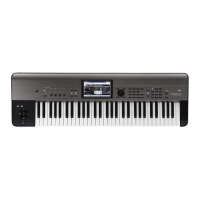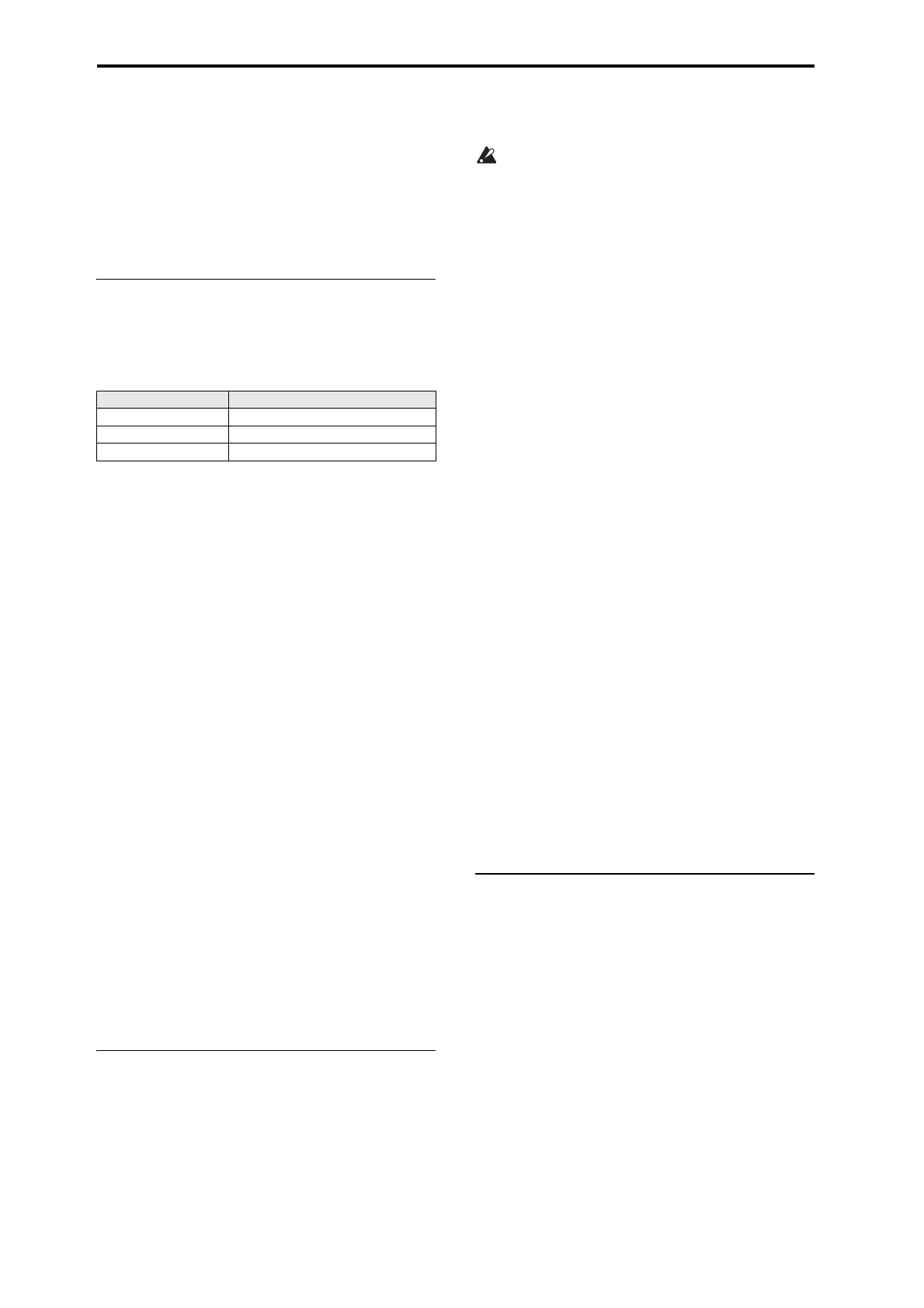Sequencer mode
146
Set this to match the MIDI channel of the MIDI track for
which you’ve assigned the drum program.
If the track’s Status is BTH, EXT, or EX2, note data etc. of the
Drum Track pattern will be transmitted.
If local control (“Local Control On Global P1:1‐1a) is on,
playing the KROME's keyboard will not make the internal
sound generator produce sound, nor can the keyboard
trigger the arpeggiator or drum track. However, they can be
triggered by note‐on messages from MIDI IN.
7–7a: Drum Pattern
Pattern [Preset, User]
[(Preset): P000...605, (User): U000...U999]
This selects the drum pattern.
• U000–U999 can be store user patterns. Patterns you create
in Sequencer mode can be converted into user drum
patterns. (see p.188)
Shift [–24...+00...+24]
This transposes the drum pattern in semitone steps. This
means that the instruments played by the pattern will
change.
MIDI Channel
Input [01...16, Tch]
This specifies the MIDI channel that will trigger the drum
pattern.
Tc h: The MIDI channel that triggers the drum pattern will
automatically be set to the MIDI channel (Seq 3–1(2)c) of the
track chosen in Track Select (Seq 0–1(2)a).
If Trigger Mode is Wait KBD Trig, and you set Track Select
to a track for which the MIDI channel you specify here is
selected, the keyboard will trigger the drum pattern. MIDI
IN messages of the matching MIDI channel will also trigger
the drum track.
Output [01...16, Tch]
This specifies the MIDI channel that will transmit the MIDI
data of the drum pattern. The drum pattern will sound
using the program of the track that is assigned to this MIDI
channel.
Tc h: The MIDI channel output will automatically be set to
match the MIDI channel (Seq 3–1(2)c) of the track selected
by Track Select (Seq 0–1(2)a).
Whether the pattern data will be output to an external
device will depend on the Status setting of the track that
matches the Output MIDI channel.
7–7b: Trigger
Trigger Mode [Start Immediately, Wait KBD Trig]
Start Immediately: When you press the DRUM TRACK
button to turn it on (LED lit), the drum pattern will start
according to the Sync setting. When you press ON/OFF
again, the drum pattern will stop.
Wait KBD Trig: When you press the DRUM TRACK button
to turn it on (LED lit), the drum pattern will wait to start. If
you set Track Select to a track that matches the MIDI
Channel Input setting, and play the keyboard, or receive a
MIDI note‐on on the same MIDI channel, the drum pattern
will start according to the Sync setting.
If you’ve selected Start Immediately, the DRUM
TRACK button will always be saved in the OFF state.
Sync [Off, On]
Off: The drum pattern will not synchronize to the currently‐
running arpeggiator, but will start immediately.
On: The drum pattern will synchronize to the currently‐
running arpeggiator.
Note: Use P7–3(4)c: Arpeggiator‐A(B) Setup Key Sync to
specify whether arpeggiator will synchronize to the
currently‐running drum pattern.
Latch [Off, On]
This is valid if Trigger Mode is Wait KBD Trig.
Off: If the DRUM TRACK button is on (LED blinking), the
pattern will start when you play the keyboard (note‐on). The
pattern will stop when you release the keyboard (note‐off).
On: If the DRUM TRACK button is on (LED blinking), the
pattern will start when you play the keyboard (note‐on). The
pattern will continue when you release the keyboard (note‐
off). The pattern will stop when you turn the DRUM
TRACK button off (LED dark).
Zone:
Keyboard
Bottom [C–1...G9]
Top [C– 1...G 9]
This is valid if Trigger Mode is set to Wait KBD Trig.
It specifies the range of keys that will start the drum pattern.
Velocity:
Bottom [001...127]
Top [001...127]
This is valid if Trigger Mode is set to Wait KBD Trig.
It specifies the range of velocities that will start the drum
pattern.
Note: You can also set the note and velocity values by
holding down an edit cell or the ENTER button and playing
a key (see OG p.10).
V
7–7: Menu Command
•0: Memory Status see p. 163
•1: Exclusive Solo see p. 64
•2: Rename Song see p. 163
•3: Delete Song see p. 163
•4: Copy From Song see p. 163
•5: Load Template Song see p. 163
•6: Save Template Song (Save as User Template Song)
see p. 164
•7: FF/REW Speed see p. 164
•8: Set Location (Set Location for Locate Key) see p. 164
•9: GM Initialize see p. 165
•10:
Copy from Combination
see p. 166
• 11: Copy from Program see p. 101
• 12: Copy Drum Track see p. 65
•13:Erase Drum Track Pattern see p. 66
For more information, please see “Sequencer: Menu
Command” on page 163.
Preset/User No. Contents
P000 Off
P000...605 Preset drum patterns
U000...U999 For user/preloaded drum patterns

